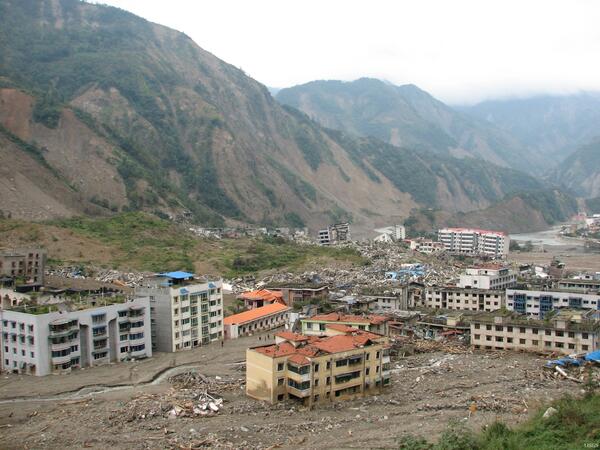Collapsed multi-story building occupied by "Centre D'Edudes La Concorde" in Port-au-Prince, a result of the magnitude-7 earthquake that struck Haiti on Jan. 12, 2010. An examination of the adjacent buildings indicates that this structure was either two or three stories tall.
Why do earthquakes in other countries seem to cause more damage and casualties than earthquakes in the U.S.?
There is more damage and more deaths from earthquakes in other parts of the world primarily because of buildings which are poorly designed and constructed for earthquake regions, and population density.
Related
At what magnitude does damage begin to occur in an earthquake?
What does an earthquake feel like?
What are those booms I sometimes hear before or during an earthquake?
How does an earthquake affect groundwater levels and water quality in wells?
Where can I find photographs of earthquake damage?
What is liquefaction?
Can you feel an earthquake if you're in a cave? Is it safer to be in a cave during an earthquake?
What are earthquake lights?
How does the USGS tell the difference between an earthquake and a sonic boom?
Collapsed multi-story building occupied by "Centre D'Edudes La Concorde" in Port-au-Prince, a result of the magnitude-7 earthquake that struck Haiti on Jan. 12, 2010. An examination of the adjacent buildings indicates that this structure was either two or three stories tall.
Collapsed multi-story residence in Port-au-Prince following the magnitude-7 earthquake that struck Haiti on Jan. 12, 2010. The weight of heavy concrete floors and roofs was often too great for the modest strength in support columns, as evidenced here.
Collapsed multi-story residence in Port-au-Prince following the magnitude-7 earthquake that struck Haiti on Jan. 12, 2010. The weight of heavy concrete floors and roofs was often too great for the modest strength in support columns, as evidenced here.

The May 12, 2008, Great Sichuan Earthquake, also called the Wenchuan Earthquake, occurred at 14:28 local time, in Sichuan Province, China. The earthquake magnitudes were Mw = 7.9 (USGS), Ms = 8.0 (Chinese Earthquake Administration). The epicenter was 80 km west-northwest of Chengdu, the capital city of Sichuan province.
The May 12, 2008, Great Sichuan Earthquake, also called the Wenchuan Earthquake, occurred at 14:28 local time, in Sichuan Province, China. The earthquake magnitudes were Mw = 7.9 (USGS), Ms = 8.0 (Chinese Earthquake Administration). The epicenter was 80 km west-northwest of Chengdu, the capital city of Sichuan province.
Collapsed residential building in Mianyang.
Collapsed residential building in Mianyang.
Collection of USGS still images taken after the January 17, 1994 Northridge earthquake highlighting the damage to buildings and infrastructure.
Collection of USGS still images taken after the January 17, 1994 Northridge earthquake highlighting the damage to buildings and infrastructure.
Using structural damage statistics to derive macroseismic intensity within the Kathmandu valley for the 2015 M7.8 Gorkha, Nepal earthquake
Assessment of existing and potential landslide hazards resulting from the April 25, 2015 Gorkha, Nepal earthquake sequence
Putting down roots in earthquake country: Your handbook for earthquakes in the Central United States
Strong ground motion in Port-au-Prince, Haiti, during the M7.0 12 January 2010 Haiti earthquake
Long-period building response to earthquakes in the San Francisco Bay Area
Putting down roots in earthquake country: Your handbook for the San Francisco Bay region
The severity of an earthquake
Earthquake damage to transportation systems
Earthquake damage to schools
Related
At what magnitude does damage begin to occur in an earthquake?
What does an earthquake feel like?
What are those booms I sometimes hear before or during an earthquake?
How does an earthquake affect groundwater levels and water quality in wells?
Where can I find photographs of earthquake damage?
What is liquefaction?
Can you feel an earthquake if you're in a cave? Is it safer to be in a cave during an earthquake?
What are earthquake lights?
How does the USGS tell the difference between an earthquake and a sonic boom?
Collapsed multi-story building occupied by "Centre D'Edudes La Concorde" in Port-au-Prince, a result of the magnitude-7 earthquake that struck Haiti on Jan. 12, 2010. An examination of the adjacent buildings indicates that this structure was either two or three stories tall.
Collapsed multi-story building occupied by "Centre D'Edudes La Concorde" in Port-au-Prince, a result of the magnitude-7 earthquake that struck Haiti on Jan. 12, 2010. An examination of the adjacent buildings indicates that this structure was either two or three stories tall.
Collapsed multi-story residence in Port-au-Prince following the magnitude-7 earthquake that struck Haiti on Jan. 12, 2010. The weight of heavy concrete floors and roofs was often too great for the modest strength in support columns, as evidenced here.
Collapsed multi-story residence in Port-au-Prince following the magnitude-7 earthquake that struck Haiti on Jan. 12, 2010. The weight of heavy concrete floors and roofs was often too great for the modest strength in support columns, as evidenced here.

The May 12, 2008, Great Sichuan Earthquake, also called the Wenchuan Earthquake, occurred at 14:28 local time, in Sichuan Province, China. The earthquake magnitudes were Mw = 7.9 (USGS), Ms = 8.0 (Chinese Earthquake Administration). The epicenter was 80 km west-northwest of Chengdu, the capital city of Sichuan province.
The May 12, 2008, Great Sichuan Earthquake, also called the Wenchuan Earthquake, occurred at 14:28 local time, in Sichuan Province, China. The earthquake magnitudes were Mw = 7.9 (USGS), Ms = 8.0 (Chinese Earthquake Administration). The epicenter was 80 km west-northwest of Chengdu, the capital city of Sichuan province.
Collapsed residential building in Mianyang.
Collapsed residential building in Mianyang.
Collection of USGS still images taken after the January 17, 1994 Northridge earthquake highlighting the damage to buildings and infrastructure.
Collection of USGS still images taken after the January 17, 1994 Northridge earthquake highlighting the damage to buildings and infrastructure.














